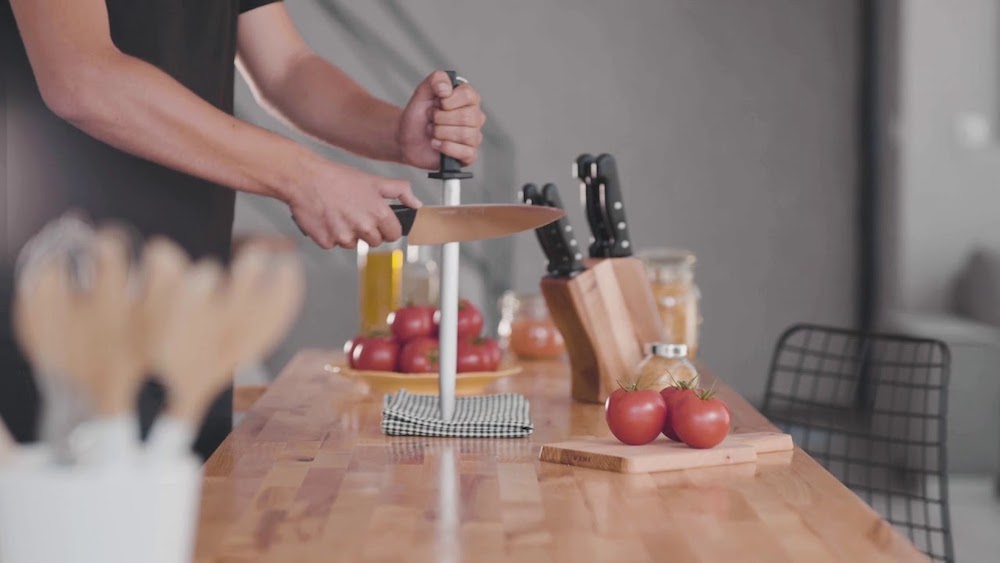A sharp meat cleaver is a crucial tool in any kitchen. It allows you to easily chop through tough meats and bones, making meal preparation faster and more efficient. However, over time, the blade of a meat cleaver can become dull and less effective. In this guide, we will show you how to sharpen a meat cleaver and keep it in top condition. With the right tools and techniques, you can restore the sharpness of your meat cleaver and ensure it continues to perform at its best.
Table of Contents
Step 1: Clean and Dry the Meat Cleaver
Before you start sharpening your meat cleaver, it’s important to clean and dry it thoroughly. This will remove any food debris or residue from the blade, making it easier to sharpen and resulting in a cleaner, sharper edge.
To clean the meat cleaver, you can use warm water and mild dish soap. Place the cleaver under running water and scrub the blade and handle with a soft sponge or brush. Rinse the cleaver well and pat it dry with a clean towel. Make sure to dry the blade and handle thoroughly, as any moisture left on the cleaver can affect the sharpening process.
If your meat cleaver is particularly dirty or has stuck-on food, you can soak it in warm water for a few minutes to loosen the debris. Be sure to use a mild dish soap, as strong detergents or abrasive cleaners can damage the blade or handle of the cleaver.
After cleaning and drying the meat cleaver, it’s important to inspect the blade for any nicks or chips. If you find any, you may need to repair them before sharpening the blade. You can use a sharpening stone or steel to carefully smooth out the nicks or chips, being careful not to remove too much metal from the blade.
Once the meat cleaver is clean, dry, and free of nicks or chips, you’re ready to move on to the next step of sharpening it.
Step 2: Select the Right Sharpening Tool
Before you start sharpening your meat cleaver, it’s important to select the right sharpening tool. The type of sharpening tool you use will depend on the condition of the blade and your personal preferences. Here are some common sharpening tools and when to use them:
- Sharpening stone: A sharpening stone, also known as a whetstone, is a versatile tool that can be used to sharpen a variety of blades, including a meat cleaver. Sharpening stones come in different grits, with coarser grits being used for dull blades and finer grits being used for sharpening and polishing the blade.
- Sharpening steel: A sharpening steel, also known as a honing steel, is a tool with a long, slender rod that is often used to maintain the sharpness of a blade. It is not suitable for sharpening a dull blade, but it can help to realign the edge of a blade that has become slightly misaligned.
- Electric sharpener: An electric sharpener is a convenient option for quickly sharpening a dull blade. It uses a motor to drive a series of sharpening wheels or disks, which grind away at the blade to sharpen it. Electric sharpeners are typically easy to use, but they can also remove a lot of metal from the blade, so it’s important to use them carefully.

When selecting a sharpening tool, consider the condition of your meat cleaver and your personal preferences. If the blade is very dull, a sharpening stone or electric sharpener may be the best option. If the blade is only slightly dull, a sharpening steel may be sufficient.
Once you’ve selected the right sharpening tool, make sure to read the instructions carefully and follow them to avoid damaging the blade.
Step 3: Sharpen the Blade Using the Sharpening Tool
Now that you’ve selected the right sharpening tool, it’s time to sharpen the blade of your meat cleaver. The specific steps for sharpening a meat cleaver will vary depending on the type of sharpening tool you’re using. Here are some general guidelines for sharpening a meat cleaver with a sharpening stone, sharpening steel, or electric sharpener:
- Sharpening stone: To sharpen a meat cleaver with a sharpening stone, first wet the stone with water or oil. Place the stone on a stable, flat surface and hold the meat cleaver at a 20-degree angle to the stone. Using light pressure, carefully draw the blade across the stone in a back-and-forth motion, starting at the tip of the blade and moving towards the handle. Repeat this motion on the other side of the blade, and then switch to a finer grit stone to polish the blade.
- Sharpening steel: To sharpen a meat cleaver with a sharpening steel, hold the sharpening steel vertically and place the blade against the steel at a 20-degree angle. Draw the blade down the length of the steel, applying light pressure and using a back-and-forth motion. Repeat this motion on the other side of the blade, and then test the sharpness of the blade.
- Electric sharpener: To sharpen a meat cleaver with an electric sharpener, follow the instructions provided by the manufacturer. Typically, you will need to clamp the blade into the sharpener and press the blade against the sharpening wheel or disk, moving it back and forth to sharpen the blade. Some electric sharpeners have different settings for different types of blades, so make sure to select the appropriate setting for a meat cleaver.
When sharpening the blade of a meat cleaver, it’s important to use light pressure and maintain a consistent angle. Avoid applying too much pressure, as this can damage the blade and remove too much metal. It’s also important to keep the blade cool by periodically rinsing it with water or applying oil to the sharpening stone.
Once you’ve sharpened the blade using the sharpening tool, you can move on to the next step of testing the sharpness of the blade.
Step 4: Test the Sharpness of the Blade
After sharpening the blade of your meat cleaver, it’s important to test the sharpness of the blade to ensure that it is sharp enough to use effectively. There are several ways to test the sharpness of a blade, including the following:
- Paper test: To perform the paper test, hold a piece of paper vertically and attempt to slice through it with the blade. If the blade is sharp, it should easily cut through the paper without tearing or shredding it. If the blade is dull, it will tear or shred the paper instead of cutting through it cleanly.
- Tomato test: To perform the tomato test, slice a tomato with the blade and observe the slice. If the blade is sharp, it should easily cut through the tomato without crushing or squashing it. If the blade is dull, it will crush or squash the tomato instead of cutting through it cleanly.
- Finger test: To perform the finger test, hold the blade against your fingertip and apply light pressure. If the blade is sharp, it should feel smooth and sharp against your finger. If the blade is dull, it will feel rough or dull against your finger.
If the blade of your meat cleaver is not sharp enough after sharpening, you can repeat the sharpening process using a finer grit stone or sharper setting on the electric sharpener. Make sure to test the sharpness of the blade again after each sharpening session to ensure that it is sharp enough to use effectively.
Once the blade of your meat cleaver is sharp, you can move on to the final step of maintaining and storing the cleaver properly.
Step 5: Maintain and Store the Meat Cleaver Properly
After sharpening the blade of your meat cleaver, it’s important to maintain and store the cleaver properly to keep it in top condition. Here are some tips on how to maintain and store your meat cleaver:
- Clean and dry the meat cleaver after each use: After using the meat cleaver, make sure to clean and dry it thoroughly to remove any food debris or residue. This will prevent the blade from rusting and keep it sharp for longer.
- Store the meat cleaver in a safe place: To prevent the meat cleaver from becoming damaged or dull, store it in a safe place. Avoid storing the cleaver in a drawer or on a counter where it can come into contact with other objects and become damaged. Instead, store it in a knife block, on a magnetic knife strip, or in a knife bag to protect the blade and handle.
- Sharpen the meat cleaver regularly: Over time, the blade of a meat cleaver can become dull and less effective. To maintain its sharpness, sharpen the meat cleaver regularly using the steps outlined in this guide. Aim to sharpen the cleaver every few months, or more often if you use it frequently.
- Use the meat cleaver for its intended purposes: A meat cleaver is designed for cutting through tough meats and bones, not for slicing vegetables or other delicate ingredients. Using the meat cleaver for purposes other than chopping meats can dull the blade and damage the handle.
By following these tips, you can maintain the sharpness and condition of your meat cleaver and ensure that it continues to perform at its best.
See also: Best Meat Cleaver Reviews

Hi, I’m Jen from New Mexico. I have been working from home as a graphic designer for a long time. While working at home, I realized that I enjoy spending time in the kitchen. The kitchen is my biggest hobby. I set up this site to relay the products and experiences I’ve tried. I review many kitchen equipment and share them with you!
